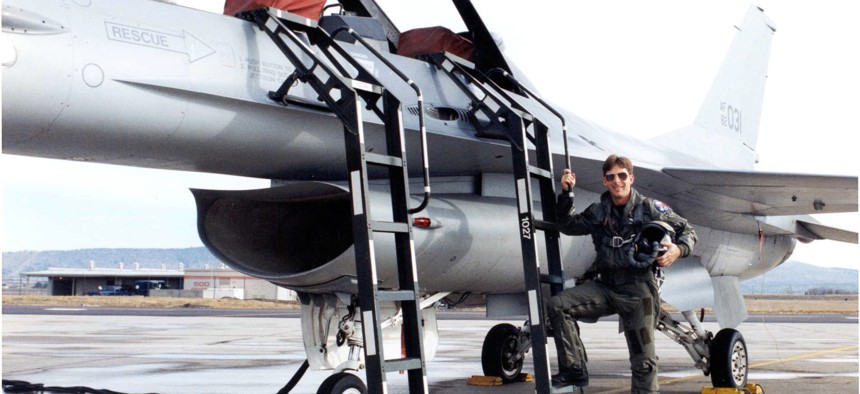
Jeff Jones, then a Navy captain, flies at Top Knife, the Air Force's fighter doc school, during an assignment as the chief of aerospace medicine with the Air Force's 147th Medical Squadron. Jones is now the chief of urology at the VA Medical Center in Houston and leading a study into why so many military pilots get prostate cancer. Courtesy / Jeff Jones
Military Pilots’ DNA May Hold Key to What’s Causing Their Prostate Cancers
Radars, magnetrons, and other toxic exposures may leave unique signatures on aviators’ cells, giving researchers the first evidence of cause.
While military pilots are getting the first acknowledgment that they are at higher risk of certain types of cancers, they still don’t know why, whether it’s something in the cockpits or on the flight decks—or something completely unrelated—that they were exposed to during their flying careers.
But one study is betting the answer may be found in their cells and DNA.
Dr. Jeffrey Jones, a career flight surgeon, retired Navy captain, and current chief of urology at Houston’s VA medical center, is shaping a study to look at the one of the markers that various toxic exposures leave on the cells of military pilots who have been diagnosed with prostate cancer. This marker, called DNA methylation, often precedes a mutation that leads to cancer, Jones said.
“If we find these areas of methylation, often the cancer is very close by there,” Jones said. “In other words, there's been a field change associated with some exposure that produced methylation, and then later, the cell’s development of frank carcinoma. So there seems to be a progression from ‘normal,’ to a methylation event, that leads to a subsequent cancer.”
The idea is that each different type of exposure, whether to solvents, fumes or the electromagnetic radiation emitted from radars and magnetrons, will produce a distinguishable methylation pattern, whether it’s found on a DNA strand or another of the microscopic components of a cell.
“We don't think it's going to be exactly the same, but we think it's going to be a similar pattern so that hopefully we could recognize it,” Jones said.
Looking at methylation patterns has also been used to show links between cigarette smoking and cancer.
Jones said his researchers would also be looking for other signatures that toxic exposure can leave on DNA or elsewhere in a cell. He said these might include specific types of chromosomal aberrations; copy number alterations, which occur when the numbers of copies of a specific gene that get replicated change; and other mutations of either the nuclear or mitochondrial DNA.
Mike Crosby, a retired Navy commander who served as an F-14 radar intercept officer and now leads the non-profit group Veterans Prostate Cancer Awareness, has also been pressing industry to study the levels and types of radiation that each piece of equipment emitted.
Pilots spent hundreds, and sometimes thousands of hours sitting just behind powerful avionics equipment that was placed in the Tomcat’s nose cone. He questions whether there was adequate shielding in those older jets.
“It’s long overdue that the services conduct an in-cockpit test to measure the radiation effects they are being exposed to,” Crosby said.
It’s hardly just a problem for military aviators. For years, service members who have suspected their cancers or other illnesses were caused by toxic exposure—for example breathing in particulate matter from massive burn pits or getting exposed to radiation or chemical weapons hazards—have struggled to get the Department of Veterans Affairs to recognize their claims.
That has begun to change. A flurry of legislation and momentum generated by private veterans organizations and within the VA has begun to take the onus off the veteran to prove a link.
“It’s very hard to determine if a specific exposure causes a particular effect in retrospect,” Jones said. “That’s why we need to look for patterns of change that are similar in these individuals, which can define a molecular signature, and begin to make an attribution of different types of exposure.”
The study will be limited to prostate cancers to further reduce variables. Prostate cancer manifests in a similar way in about 85 percent of men, Jones said.
But it’s also personal for Jones; as a Navy flight surgeon assigned to the U.S. Marine Corps, he flew hundreds of hours on a variety of aircraft, including the EA-6B Prowler, the F-18 Hornet, AH-1s, C-40s, and C-130s.
In 2019, at 59, he was also diagnosed with prostate cancer.
An Air Force study released earlier this year found that pilots were 23 percent more likely to develop prostate cancer than non-flying service members and 19 percent more likely to develop prostate cancer than the U.S. general population.
Jones said about 1,000 military aviation veterans have signed up to be part of the study, which is being supported by Veterans Prostate Cancer Awareness. The study would examine the service histories of those veterans—where they served, what they flew, what ordnance and equipment was on board, and other health factors to begin to isolate causes.
The study has not yet begun, Jones and others are still working to secure funding for it and hosting a fundraiser with Veterans Prostate Cancer Awareness aboard the retired aircraft carrier USS Midway in San Diego this month.




